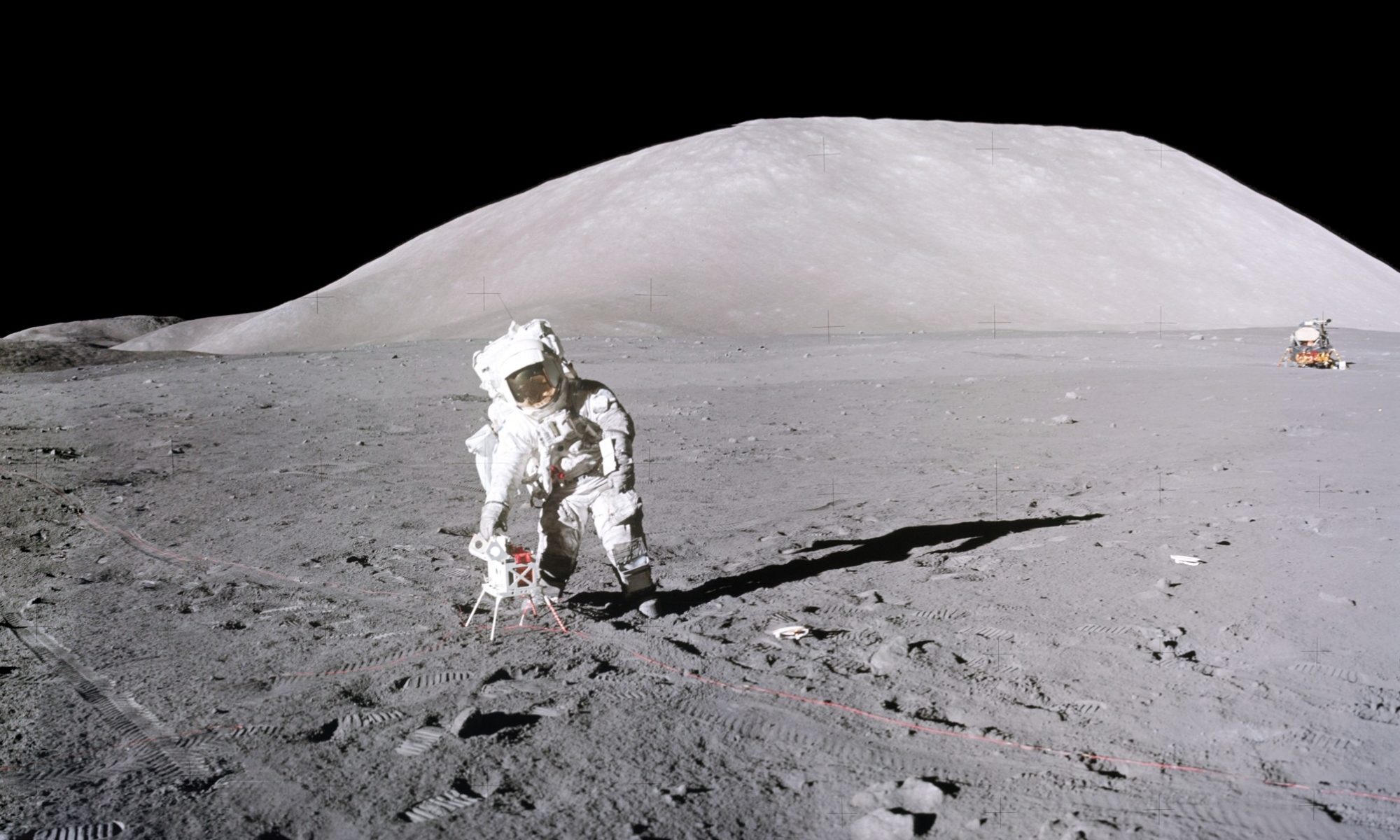 At Station 6 on EVA-3, we spent more than an hour examining, sampling and documenting a large, now fragmented boulder that had rolled down and across the south-facing slope of the ~1600 m high North Massif. Investigating this boulder was a major goal of this final EVA, as it was the largest boulder that could be identified on pre-mission images. Here, near Block 1 during Cernan’s final panoramic documentation of the site, I am carrying the gnomon back towards the Rover after observing and sampling the east side of the boulder. The shortest distance between me and the LRV parked to the right of the photo is through a gap between blocks 2 and 3 and 4 and 5 (see Fig. 12.37 in §1) that exits just to the left of the Rover where the hood of the TV camera is pointing. The vertical arrow in the distance points to the LM Challenger, located ~3.1 km away. An unmarked, higher resolution version of this pan can be downloaded from here. (Combination of NASA photos AS17-140-21497, -95, -96).
At Station 6 on EVA-3, we spent more than an hour examining, sampling and documenting a large, now fragmented boulder that had rolled down and across the south-facing slope of the ~1600 m high North Massif. Investigating this boulder was a major goal of this final EVA, as it was the largest boulder that could be identified on pre-mission images. Here, near Block 1 during Cernan’s final panoramic documentation of the site, I am carrying the gnomon back towards the Rover after observing and sampling the east side of the boulder. The shortest distance between me and the LRV parked to the right of the photo is through a gap between blocks 2 and 3 and 4 and 5 (see Fig. 12.37 in §1) that exits just to the left of the Rover where the hood of the TV camera is pointing. The vertical arrow in the distance points to the LM Challenger, located ~3.1 km away. An unmarked, higher resolution version of this pan can be downloaded from here. (Combination of NASA photos AS17-140-21497, -95, -96).
Author’s Note
“Pages of History” constitutes the seventh installment of “Apollo 17: Diary of the Twelfth Man”. It is Chapter 12 of the “Diary” with other chapters to follow as soon as time permits, some of them out of sequence. This chapter chronicles EVA-3, the continuation of the exploration of the lunar surface at Taurus-Littrow on the third day after landing, exactly 48 years ago today. This day consisted of a clockwise drive around the valley to visit Stations 6 and 7 on the slopes of the North Massif ~3-3.5 km away; a stop at Station 8, a further 700 m distance on the slope of the Sculptured Hills; and visiting Station 9, ~2 km from Station 8; and finally, returning another ~2 km to the LM. The total circuit for the day amounted to roughly 12 km (distances rounded from the NAV odometer readings). Photos from this circuit provide some of the most remarkable views of the valley. The title of the chapter reflects the ~50 years of analyses of the rock and soil samples we obtained along this route, which bear on the origin of the massifs; determine the ages of several large lunar impact basins; and also relate to similar events occurring on the Earth during that period. The chapter ends with the return to the LM and a close-out of EVA-3, so far the most recent in history, which includes my Olympic record-breaking hammer throw!
The co-editor of this “Diary”, Ronald Wells, has greatly enhanced this chapter, as he has other chapters, by his remarkable attention to the Hasselblad images and panoramas obtained at various stations. The reader’s experience, as well as that of the author, penetrates far more deeply into the exploration of the valley of Taurus-Littrow as a result of Dr. Wells’ work than otherwise would be possible.
As before, the liberal use of endnotes, distinguishing between subjects and sources is aided by the consistent use of different font styles and colors in the text. The first endnote of the chapter repeats the explanation of these color codes.
To continue reading, click “Chapter 12 – Pages of History!” in the sidebar at upper right under “C. Chapters 10 – 18”. That page leads directly to the chapter table of contents. The chapter is divided into three sections, and the sub-heads in each section provide the reader with a list of links to various points in the chapter to facilitate later readings. Alternatively, click the various section numbers underneath the “Chapter 12 – Pages of History” heading to by-pass the table of contents and go directly to the beginning of the chapter.
One can, of course, also begin the whole “Diary” from the beginning by clicking on the header, “1. Apollo 17: Diary of the 12th Man”, in the “Pages” sidebar at the top upper right.
(Ed. note: Chapter 12, Section 3 has been added)
Copyright © by Harrison H. Schmitt, 2020, 2021. All rights reserved.
